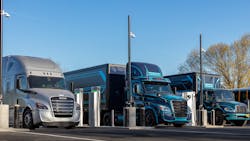Could the push for EVs be a wake-up call for modern infrastructure?
The nation’s aging electric grid is being pushed to do more than it was designed to do. And with more than 70% of grid transmission lines and power transformers over 25 years old, according to the U.S. Department of Energy, doubts loom concerning the viability of widescale battery-electric vehicles.
The American Transportation Research Institute just published its latest study on "Charging Infrastructure Challenges for the U.S. Electric Vehicle Fleet." The report points to the difference in electricity generation produced versus consumption across the U.S. and highlights a significant amount of electricity that is being produced, but not delivered to end users due to average line losses at transformers and during transmission and distribution.
See also: ATRI identifies top BEV adoption barriers
So, where does this leave fleets looking to make the transition to BEVs? And who, in the end, is responsible for addressing utility concerns and improving the interoperability of charging stations? These concerns were addressed during a Dec. 6 Verge Net Zero virtual conference panel discussion that included Rob Reich, EVP and chief administrative officer at Schneider; Hari Nayar, VP of fleet electrification and sustainability at Merchants Fleet; Sam Morales, senior manager of carrier programs at Convoy; and Chris Busch, transportation director and senior economist at Energy Innovation.
For Nayar, charging station interoperability will be a shared responsibility among the vehicle OEM, the charging station manufacturer, and the grid operator. As it stands today, even with the “perfect charger” or “perfect” vehicle pulling up to that charger, power capacity inadequacies remain problematic.
“In some ways, EVs might be the best thing that can happen to the grid because, for one, it is currently putting the spotlight on the necessity for grid modernization,” Nayar said. “We have taken the grid for granted thus far and it’s the single largest contiguous supply chain that exists if you think about it.”
Charging complications
Companies like Schneider, which expects to receive its first order of Class 8 battery-electric vehicles for its intermodal drayage fleet in Southern California in January, are learning just how complicated installing charging infrastructure can be.
Just last week, Schneider announced that it would take delivery of 92 Class 8 Freightliner eCascadias, manufactured by Daimler Truck North America. Battery-electric trucks are part of Schneider’s sustainability goals to reduce CO2 per-mile emissions by 7.5% by 2025 and 60% by 2035.
“Most of our work at Schneider so far has been focused on battery-electric vehicles because of the availability,” Rob Reich, EVP and chief administrative officer at Schneider, said during the Verge Net Zero session. “We think the future is definitely electric, and we think there is a big opportunity for battery-electric vehicles.”Schneider is installing charging infrastructure at its intermodal facility in El Monte, California, and the carrier intends to slip-seat trucks that will operate two shifts a day and return to the El Monte location for charging.
“The lesson learned on infrastructure is that it's complicated and it takes longer than we thought to get it all planned and implemented,” Reich said. “One of our takeaways from our first project is that it’s about a two-year process to really put a good charging infrastructure plan in place. The truck part is a little easier. We are used to deploying trucks.”
Merchants Fleet, which offers rental solutions and consultation services to help carriers test EVs and emerging technologies, has committed to 40,000 EV reservations from varying OEMs for fleets over the next couple of years. According to Nayar, the vehicles offered thus far are predominantly battery-electric; however, Merchants’ consultants are keeping their eyes on hydrogen fuel-cell electrics in the medium-duty and heavy-duty sectors.
“This transformation we are looking at is not just the vehicle,” Nayar said. “You have to be an expert on the fueling side of it. Fleet operators, especially for heavy-duty vehicles, are now having to take that pioneering step forward to deploy charging infrastructure as part of the package itself.”
Across the country, Nayar reiterated that interoperability among charging networks remains a major problem to overcome.
“The drivers should not be expected to show up at a station and have to figure out if is this an EVgo station, if this is a ChargePoint station, or call and wait for support,” he noted. “Asking the operator to make that connection to make the vehicle a success is just putting up another barrier for adoption.”
Digital freight brokers like Convoy are also trying to work through these problem areas when they are pairing shippers and carriers. Convoy typically works with owner-operators and smaller carriers, so a lot of the discussion has been focused on how smaller operators can adopt new technologies.
“We started piloting and partnering with OEMs and specific shippers that have pretty aggressive sustainability initiatives and learning what does planning look like, what does operations look like, and what does that carrier profile look like to be able to actually execute this,” Morales said. “We’re definitely in the infancy of building this out, but our goal is figuring out how to optimize this type of technology for any type of carrier network-wide, and then how do we get this out of California?”
Convoy is also working with a variety of shippers that expressed interest in carriers that are ready to use EVs as well, Morales added. Some shippers that are using electric hostlers and other light-duty EVs already have some charging infrastructure at their facilities. The challenge, Morales said, has been finding chargers that are compatible with Class 8s.
“How efficient can we be from a charging perspective if we only had two chargers at the facility that we had to share with this other equipment,” Morales surmised.
Then, vehicle charge times, utilization, routing, scheduling, and training further compound the problem.
“Because publicly available charging infrastructure is a bit sparse, when you look at where it's available, those routes and availability don’t always overlap,” Morales said. “So, there is a major dependence on initial pioneers in this industry to have their own infrastructure and to have more flexibility to test.”
The Tesla Semi and other innovations
Earlier this month, Tesla delivered its first battery-electric heavy-duty vehicle to PepsiCo. The major milestone here is that Tesla’s Semi completed a 500-mile drive on a single charge.
Initial reactions have been a mix of excitement and skepticism. Convoy’s Morales expressed excitement from an innovation perspective and was impressed with a 500-mile run on a single charge. However, he noted that local infrastructures aren’t set up for this.
“These Tesla day cabs consume a megawatt of power to charge, so that would put a lot of houses without energy,” Morales explained. “There is a lot that needs to be done to lower the cost, improve the experience, to really extend this technology everywhere, but it doesn’t take away how exciting it was to see Tesla complete a 500-mile route.”
Others agreed.
“I see it as a major technological leap, but it’s still too early to say this is going to be a commercially viable solution,” Nayar noted. “From a pure operations standpoint, getting a battery-electric truck—let’s assume it was fully loaded—to move 500 miles on a single charge is a phenomenal accomplishment, there is no question about it.”
“In the OEM world, it’s taking a one-off to production and being able to sustain that performance over multiple generations of production,” he added. “Keep in mind, this truck is a behemoth when it comes to the energy capacity on it. It needs a megawatt charger, so the cost of that charger also has to be factored into the total cost of ownership of that vehicle. This is an industry that is driven predominantly by TCO. I see this as a wonderful technologic step forward, but time will tell if the commercial viability of this will go through.”
Schneider’s Reich echoed that focus on TCO. On whether he believes battery-electric will be a solution for long-haul operations, Reich said that Schneider’s current assumption is “no,” with hydrogen as the most viable alternative.
“We’ll have to see how this 500-mile range plays out from an overall TCO standpoint,” Reich said. “Our assumption today is that battery-electric is a great drayage, shorter haul, dedicated type of solution and likely it’s more of a hydrogen fuel cell or hydrogen internal combustion engine or other alternatives that solve that more medium and longer length of haul.”
When it comes to other important steps in the meantime, Reich emphasized the importance of not losing sight of efforts to make diesel a cleaner fuel source, as well as the other technologies OEMs are using in trucks and engines to make them more efficient.
“I think there are other exciting short-term things, and it’s that ‘messy middle,’” he said referring to the North American Council for Freight Efficiency’s term. “I think the messy middle can be exciting as well.”
As a broker, Convoy prides itself with matching shippers and carriers efficiently to eliminate empty trailers rolling down the highway within its network, Morales explained.
“On average, 35% of any trailer on the highway today is running empty,” Morales said. “If you think about the impact that has, there is a lot of groundwork and efficiency between partners—shippers, carriers, planners—to improve the utilization of equipment today, plus investing in the technology to get to zero emissions. There is a lot of work that can be done between now and the next 20 years in that space.”
This article originally appeared in FleetOwner.com.
About the Author

Cristina Commendatore
Cristina Commendatore is the Executive Editor of FleetOwner magazine. She has reported on the transportation industry since 2015, covering topics such as business operational challenges, driver and technician shortages, truck safety, and new vehicle technologies. She holds a master’s degree in journalism from Quinnipiac University in Hamden, Connecticut.

